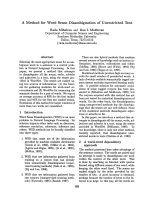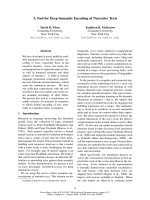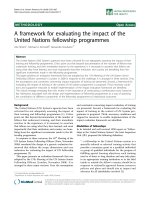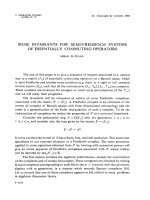Báo cáo toán học: "A Bound for Size Ramsey Numbers of Multi-partite Graphs" pot
Bạn đang xem bản rút gọn của tài liệu. Xem và tải ngay bản đầy đủ của tài liệu tại đây (86.73 KB, 5 trang )
A Bound for Size Ramsey Numbers of Multi-partite
Graphs
Yuqin Sun and Yusheng Li
∗
Department of Mathematics, Tongji University
Shanghai 200092, P. R. China
, li
Submitted: Sep 28, 2006; Accepted: Jun 8, 2007; Published: Jun 14, 2007
Mathematics Subject Classification: 05C55
Abstract
It is shown that the (diagonal) size Ramsey numbers of complete m-partite
graphs K
m
(n) can be bounded from below by cn
2
2
(m−1)n
, where c is a positive
constant.
Key words: Size Ramsey number, Complete multi-partite graph
1 Introduction
Let G, G
1
and G
2
be simple graphs with at least two vertices, and let
G → (G
1
, G
2
)
signify that in any edge-coloring of edge set E(G) of G in red and blue, there is either
a monochromatic red G
1
or a monochromatic blue G
2
. With this notation, the Ramsey
number r(G
1
, G
2
) can be defined as
r(G
1
, G
2
) = min{N : K
N
→ (G
1
, G
2
)}
= min{|V (G)| : G → (G
1
, G
2
)}.
As the number of edges of a graph is often called the size of the graph, Erd˝os, Faudree,
Rousseau and Schelp [2] introduced an idea of measuring minimality with respect to size
rather than order of the graphs G with G → (G
1
, G
2
). Let e(G) be the number of edges
of G. Then the size Ramsey number ˆr(G
1
, G
2
) is defined as
ˆr(G
1
, G
2
) = min{e(G) : G → (G
1
, G
2
)}.
∗
Supported in part by National Natural Science Foundation of China.
the electronic journal of combinatorics 14 (2007), #N11 1
As usual, we write ˆr(G, G) as ˆr(G). Erd˝os and Rousseau in [3] showed
ˆr(K
n,n
) >
1
60
n
2
2
n
. (1)
Gorgol [4] gave
ˆr(K
m
(n)) > cn
2
2
mn/2
, (2)
where and henceforth K
m
(n) is a complete m-partite graph with n vertices in each part,
and c > 0 is a constant. Bielak [1] gave
ˆr(K
n,n,n
) > c
n
n
2
2
2n
, (3)
where c
n
→
3
1/3
4e
8/3
as n → ∞. We shall generalize (1) and (3) by improving (2) as
ˆr(K
m
(n)) > cn
2
2
(m−1)n
,
where c = c
m
> 0 that has a positive limit as n → ∞.
2 Main results
We need an upper bound for the number of subgraphs isomorphic to K
m
(n) in a graph
of given size. The following counting lemma generalizes a result of Erd˝os and Rousseau [3]
and we made a minor improvement for the case m = 2.
Lemma 1 Let n ≥ 2 be an integer. A graph with q edges contains at most A(m, n, q)
copies of complete m-partite graph K
m
(n), where
A(m, n, q) =
2eq
(m − 1)m!n
2e
2
q
n
2
mn/2
2m − 2
m
(m−2)n/2
.
Proof. Let F denote K
m
(n) and let G be a graph of q edges on vertex set V . Set
s =
e(F )
2
log
2q
e(F )
,
where log x is the natural logarithmic function. Set d
s+1
= ∞ and
d
k
= (m − 1)ne
k/e(F )
, k = 0, 1, 2, · · · , s,
and
X
k
= {x ∈ V : d
k
≤ deg(x) < d
k+1
}.
Then X
0
, X
1
, . . . , X
s
form a partition of the set W
0
= {x ∈ V : deg(x) ≥ (m − 1)n}. Let
W
k
= ∪
s
j=k
X
j
= {x ∈ V : deg(x) ≥ d
k
}.
Let us say that a subgraph F in G is of type k if k is the smallest index such that
X
k
∩ V (F ) = φ. Then
the electronic journal of combinatorics 14 (2007), #N11 2
• every vertex of V (F ) belongs to W
k
;
• at least one vertex of V (F ) belongs to X
k
.
Let M
k
be the number of type k copies of F in G. Then M =
s
k=0
M
k
is the total
number of copies of F . Notice that in a type k copy of F at least one vertex, say x,
belongs to X
k
and every vertex belongs to W
k
. Thus all F −neighbors of x belong to an
(m−1)n-element subset Y of the G−neighborhood of x in W
k
. Moreover all other (n − 1)
vertices of F belong to an (n−1)-element subset of W
k
−Y −{x}. Since the neighborhood
of x in F is a complete (m − 1)-partite graph, say H, then we get at most
t(m, n) =
1
(m − 1)!
(m − 1)n
n
(m − 2)n
n
· · ·
2n
n
n
n
subgraphs isomorphic to H in the graph induced by the set Y . Furthermore, the m parts
in K
m
(n) can be interchanged arbitrarily. Note that a vertex x ∈ X
k
has degree at most
d
k+1
, so
M
k
≤ |X
k
|
t(m, n)
m
d
k+1
(m − 1)n
|W
k
|
n
.
The elementary formulas
D
t
t
n
=
D
n
D − n
t − n
and
D
n
≤
D
n
n!
<
eD
n
n
give
d
k+1
(m − 1)n
(m − 1)n
n
(m − 2)n
n
· · ·
2n
n
≤
d
k+1
n
d
k+1
− (m − 1)n
(m − 2)n
(m − 2)n
n
· · ·
2n
n
≤
d
k+1
n
d
k+1
(m − 2)n
(m − 2)n
n
· · ·
2n
n
≤
d
k+1
n
m−1
≤
ed
k+1
n
(m−1)n
.
It implies that for k = 0, 1, 2, . . . , s − 1,
M
k
≤
|X
k
|
m!
ed
k+1
n
m−1
e|W
k
|
n
n
≤
|X
k
|
m!
e
m
n
2
d
k+1
n
m−2
d
k+1
|W
k
|
n
.
the electronic journal of combinatorics 14 (2007), #N11 3
From the definition of W
k
, we have d
k
|W
k
| ≤ 2q. Hence
d
k+1
|W
k
| = d
k
|W
k
|e
1/e(F )
≤ 2qe
1/e(F )
,
and d
k+1
/n = (m − 1)e
(k+1)/e(F )
, so
M
k
≤
|X
k
|
m!
2qe
m
(m − 1)
m−2
n
2
exp
(m − 2)k + m − 1
e(F )
n
.
As k ≤ s − 1 ≤
e(F )
2
log
2q
e(F )
and e(F ) = m(m − 1)n
2
/2,
exp
(m − 2)k + m − 1
e(F )
≤ e
2/(mn
2
)
4q
m(m − 1)n
2
(m−2)/2
,
and hence
M
k
≤
e|X
k
|
m!
·
2e
2
q
n
2
mn/2
2m − 2
m
(m−2)n/2
.
Since d
s
≥ 2e
−1/e(F )
(m − 1)q/m, so |X
s
| = |W
s
| ≤ e
1/e(F )
mq/(m − 1), and if the
subgraph F is of type s, then each vertex of V (F ) must belong to X
s
. Thus we have
M
s
≤
t(m, n)
m
|X
s
|
(m − 1)n
|X
s
|
n
<
1
m!
|X
s
|
n
m
≤
e
m!
2e
2
q
n
2
mn/2
m
2m − 2
mn/2
.
If |X
s
| = 0 then |M
s
| = 0; thus we can write
M
s
≤
e|X
s
|
m!
2e
2
q
n
2
mn/2
m
2m − 2
mn/2
.
Hence for all k = 0, 1, . . . , s, we have
M
k
≤
e|X
k
|
m!
2e
2
q
n
2
mn/2
2m − 2
m
(m−2)n/2
.
Finally, we obtain
M =
s
k=0
M
k
≤ |W
0
| ·
e
m!
2e
2
q
n
2
mn/2
2m − 2
m
(m−2)n/2
≤
2eq
n(m − 1)m!
2e
2
q
n
2
mn/2
2m − 2
m
(m−2)n/2
.
The assertion follows.
the electronic journal of combinatorics 14 (2007), #N11 4
Theorem 1 Let m ≥ 2 be fixed and n → ∞, then
ˆr(K
m
(n)) > (c − o(1))n
2
2
(m−1)n
,
where c =
m
16e
2
(m−1)
4m−4
m
2/m
.
Proof. We shall prove that
ˆr(K
m
(n)) > c(m, n)n
2
2
(m−1)n
,
where
c(m, n) =
m
16e
2
(m − 1)
4m − 4
m
2/m
(m − 1)m!
4en
2/(mn)
.
Let G be arbitrary graph with q edges, where q ≤ c(m, n) n
2
2
(m−1)n
. Let us consider a
random red-blue edge-coloring of G, in which each edge is red with probability 1/2 and
the edges are colored independently. Then the probability P that such a random coloring
yields a monochromatic copy of K
m
(n) satisfies
P ≤
4eq
n(m − 1)m!
2e
2
q
n
2
mn/2
2m − 2
m
(m−2)n/2
1
2
m(m−1)n
2
/2
<
4en
2
2
(m−1)n
n(m − 1)m!
(2e
2
)
mn/2
2m − 2
m
(m−2)n/2
c
mn/2
= 1.
Thus G → (K
m
(n), K
m
(n)), and the desired lower bound follows from the fact that
c(m, n) → c as n → ∞.
References
[1] H. Bielak, Size Ramsey numbers for some regular graphs, Electronic Notes in Discrete
Math. 24 (2006), 39–45.
[2] P. Erd˝os, R. Faudree, C. Rousseau and R. Schelp, The size Ramsey numbers, Period.
Math. Hungar. 9 (1978) 145–161.
[3] P. Erd˝os and C. Rousseau, The size Ramsey number of a complete bipartite graph,
Discrete Math. 113 (1993), 259–262.
[4] I. Gorgol, On bounds for size Ramsey numbers of a complete tripartite graph, Discrete
Math. 164 (1997), 149–153.
the electronic journal of combinatorics 14 (2007), #N11 5









